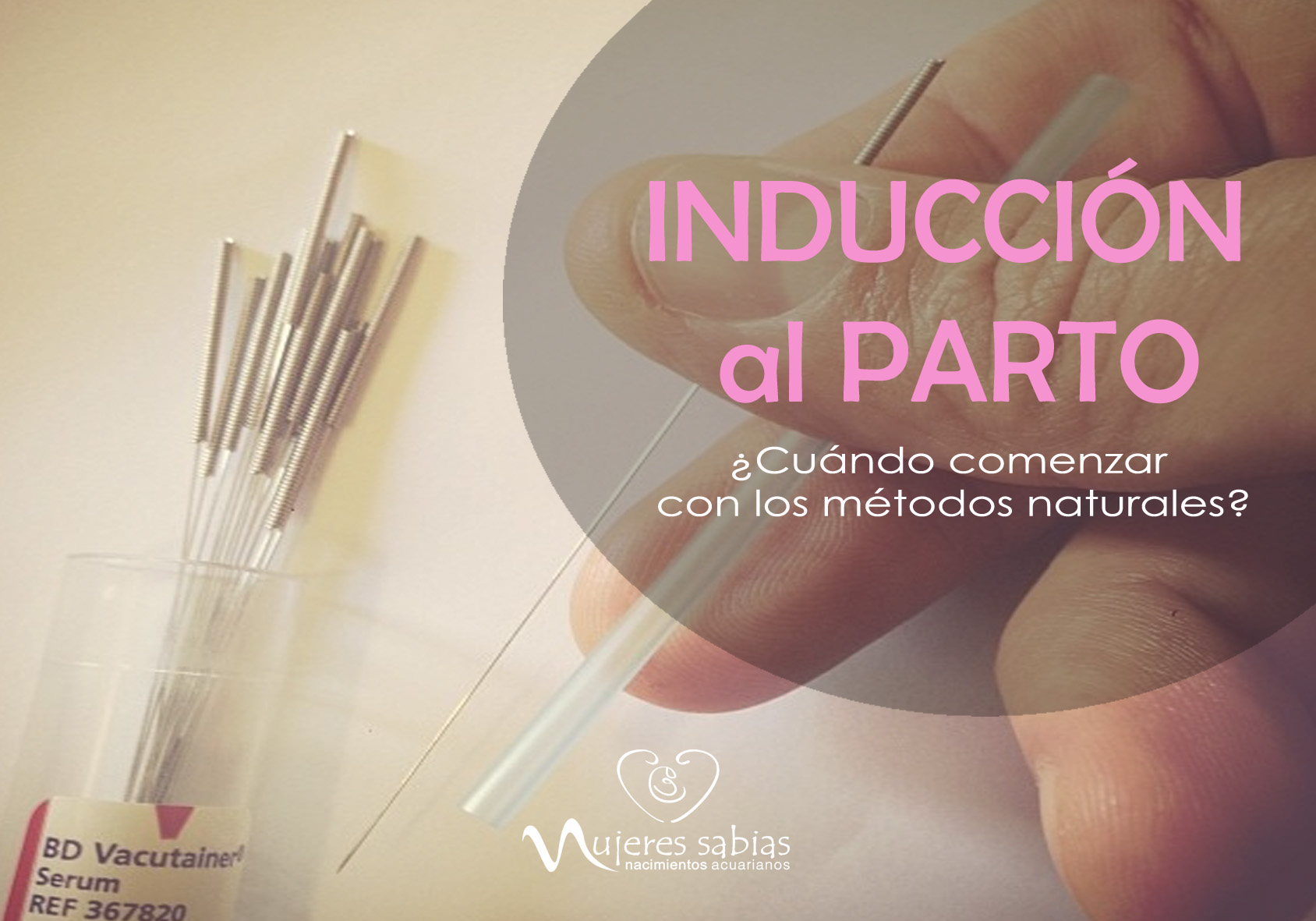¿Cuándo empezar con los métodos naturales para inducción al parto?
Antes que nada me gustaría empezar por:
¿Qué entendemos como métodos naturales?
Generalmente cuando realizamos una inducción hay dos fases: una en la que se intenta madurar el cuello con fármacos tipo prostaglandinas y otro en el que se intenta dilatar el cuello y que el bebé entre en la pelvis, para que posteriormente salga por la vagina, generalmente utilizando oxitocina intravenosa.
Cuando nos referimos a los métodos naturales solemos hablar de métodos diferentes a estos, ya sabéis que la palabra ‘natural’ es un concepto vago que se utiliza de una manera muy frecuente pero que tiene muchas veces significados varios.
Normalmente cuando las mujeres nos preguntan por métodos naturales suelen referirse a métodos ‘no farmacológicos’ y ‘poco invasivos’, o a sencillamente que no sean prostaglandinas u oxitocina.
Dentro de estos métodos estarían: infusiones, ingesta de algunos alimentos, masajes con ciertas esencias, acupuntura, homeopatía, estimulación de pezones, aceite de ricino, aceite de onagra, relaciones sexuales… e incluso podríamos también hablar de la maniobra de hamilton y de la dilatación mecánica con sonda foley (y es que el término natural es muy amplio).
El caso es que cuando una mujer nos consulta porque está preocupada porque siente miedo de no ponerse de parto y necesitar una inducción, siempre nos suele preguntar que cuándo es mejor comenzar.
La evidencia científica (os voy a dejar enlaces a estudios más abajo) dice que estos métodos pueden ser eficaces en madurar el cuello del útero, es decir, que pueden ayudar a simular el preparto que pueden propiciar así el inicio del trabajo de parto (aprovecho para apuntar que no todos los métodos que he citado tienen evidencia de ser eficaces y no todos en el mismo grado, si queréis puede hacer otro artículo contando qué métodos son eficaces y de qué nivel de eficacia estamos hablando)
¿Qué dice nuestra experiencia?
Que sí, es cierto, estos métodos ayudan a tener contracciones, de verdad que sí, pero generalmente contracciones suaves y si el parto está cerca sí, muchas veces esas contracciones se pueden ir animando y la mujer puede terminar poniéndose de parto.
Pero, el parto tiene que estar cercano. Es decir si comienzas a realizarlos pero realmente queda mucho para el nacimiento, entiende mucho como varias semanas, sencillamente no va a suceder, los receptores del útero no van a estar activados y no va a suceder.
Estos métodos lo que pueden hacer es adelantar el momento unos días.
Así que ¿qué aconsejamos nosotras?
Nosotras aconsejamos que mientras no haya un motivo para tener prisa por acabar el embarazo sencillamente se espere, porque siempre va a ser más seguro que el parto comience por si solo, en el momento que el bebé y la mamá han elegido y a su ritmo.
Y cuando la fecha de una posible inducción está cerca entonces sí tratar de realizar estas técnicas por si realmente el parto estuviera cerca y propiciar su comienzo antes de llegar a inducir.
Porque estas técnicas ‘naturales’ no dejan de tener riesgos y entendemos que solo deberían de asumirse cuando la alternativa es una ‘inducción farmacológica’ la uso (es decir, prostaglandinas y oxitocina).
![]()
Esta es nuestra manera de plantearlo así en general, pero como siempre individualizamos, siempre depende de cada caso, teniendo en cuenta las necesidades y deseos de cada mujer. Y aprovecho a decir que no planteamos todas para todas las mujeres, más arriba en el texto simplemente he citado las más famosas o por las que más nos preguntan las mujeres.
![]()
Aquí os dejo estudios con info interesante sobre la eficacia:
(Sí, lo sé hay muchísimos, así que si te apetece que os los resuma,¡¡¡pónmelo en los comentarios!!!)
Un abrazo,
Gemma
- Azhari, S., Pirdadeh, S., Lotfalizadeh, M., & Shakeri, M. T. (2006). Evaluation of the effect of castor oil on initiating labor in term pregnancy. Saudi Med J, 27(7), 1011-1014.
- Boel, M. E., Lee, S. J., Rijken, M. J., Paw, M. K., Pimanpanarak, M., Tan, S. O., . . . McGready, R. (2009). Castor oil for induction of labour: not harmful, not helpful. Aust N Z J Obstet Gynaecol, 49(5), 499-503.
- Boltman-Binkowski, H. (2016). A systematic review: Are herbal and homeopathic remedies used during pregnancy safe? Curationis, 39(1), 1514.
- El Mauhoub, M., Khalifa, M. M., Jaswal, O. B., & Garrah, M. S. (1983). “Ricin syndrome”. A possible new teratogenic syndrome associated with ingestion of castor oil seed in early pregnancy: a case report. Ann Trop Paediatr, 3(2), 57-61.
- Garry, D., Figueroa, R., Guillaume, J., & Cucco, V. (2000). Use of castor oil in pregnancies at term. Altern Ther Health Med, 6(1), 77-79.
- Gilad, Ronnie, Hohner, Haiti, Vinograd, Orit, . . . Shay. (2012). The CIC Trial–castor oil for induction of contractions in post-term pregnancies. American Journal of Obstetrics and Gynecology, 206(1), S77-S78.
- Kelly, A. J., Kavanagh, J., & Thomas, J. (2013). Castor oil, bath and/or enema for cervical priming and induction of labour. Cochrane Database Syst Rev(7), CD003099.
- Mozurkewich, E. L., Chilimigras, J. L., Berman, D. R., Perni, U. C., Romero, V. C., King, V. J., & Keeton, K. L. (2011). Methods of induction of labour: a systematic review. BMC Pregnancy Childbirth, 11, 84.
- O’Sullivan, M. D., Hehir, M. P., O’Brien, Y. M., & Morrison, J. J. (2010). 17 alpha-hydroxyprogesterone caproate vehicle, castor oil, enhances the contractile effect of oxytocin in human myometrium in pregnancy. Am J Obstet Gynecol, 202(5), 453.e451-454.
- Patel, V. R., Dumancas, G. G., Kasi Viswanath, L. C., Maples, R., & Subong, B. J. (2016). Castor Oil: Properties, Uses, and Optimization of Processing Parameters in Commercial Production. Lipid Insights, 9, 1-12. .
- Salami, S. A., & Raji, Y. (2015). Generational reproductive outcomes in Wistar rats maternally exposed to Ricinus communis oil at different stages of gestation. J Dev Orig Health Dis, 6(5), 443-453.
- Steingrub, J. S., Lopez, T., Teres, D., & Steingart, R. (1988). Amniotic fluid embolism associated with castor oil ingestion. Crit Care Med, 16(6), 642-643.
- Tunaru, S., Althoff, T. F., Nüsing, R. M., Diener, M., & Offermanns, S. (2012). Castor oil induces laxation and uterus contraction via ricinoleic acid activating prostaglandin EP3 receptors. Proc Natl Acad Sci U S A, 109(23), 9179-9184.
- Bamford, D. S., Percival, R. C., & Tothill, A. U. (1970). Raspberry leaf tea: a new aspect to an old problem. British Journal of Pharmacology, 40(1), 161P+.
- Beckett, A. H., Belthle, F. W., & Fell, K. R. (1954). The active constituents of raspberry leaves; a preliminary investigation. J Pharm Pharmacol, 6(11), 785-796.
- Burn, J.H. and Withell, E.R. (1941). A principle in raspberry leaves which relaxes uterine muscle. Lancet, Volume 238 , Issue 6149 , 1 – 3.
- Dante, G., Pedrielli, G., Annessi, E., & Facchinetti, F. (2013). Herb remedies during pregnancy: A systematic review of controlled clinical trials. J Matern Fetal Neonatal Med, 26(3), 306-312.
- European Medicines Agency Committee on Herbal Medicinal Products; London, UK: 2013. Assessment Report on Rubus idaeus L., Folium.
- Holst, L., Haavik, S., & Nordeng, H. (2009). Raspberry leaf–should it be recommended to pregnant women? Complement Ther Clin Pract, 15(4), 204-208.
- Jing Zheng, Pistilli, M. J., Holloway, A. C., & Crankshaw, D. J. (2010). The effects of commercial preparations of red raspberry leaf on the contractility of the rat’s uterus in vitro. Reprod Sci, 17(5), 494-501.
- Johnson, J. R., Makaji, E., Ho, S., Boya Xiong, Crankshaw, D. J., & Holloway, A. C. (2009). Effect of maternal raspberry leaf consumption in rats on pregnancy outcome and the fertility of the female offspring. Reprod Sci, 16(6), 605-609.
- Parsons M, Simpson M,Ponton T. Raspberry leaf and its effect on labour: safety and efficacy.Aust Coll Midwives Inc J 1999;12:20–5.
- Patel AV, Obiyan J, Patel N, Dacke CG. Raspberry leaf extract relaxes intestinal smooth muscle in vitro. J Pharm Pharmacol 1995;47:1129.
- Rojas-Vera, J., Patel, A. V., & Dacke, C. G. (2002). Relaxant activity of raspberry (Rubusidaeus) leaf extract in guinea-pig ileum in vitro. Phytother Res, 16(7), 665-668.
- Simpson M, Parsons M, Greenwood J, Wade K. Raspberry leaf in pregnancy: its safety and efficacy in labor. J Midwifery Womens Health 2001;46:51–9
- Adewole, I. F., et al. (1993). “Cervical ripening and induction of labour by breast stimulation.” Afr J Med Med Sci22(4): 81-85.
- Chayen, B., et al. (1986). “Induction of labor with an electric breast pump.” J Reprod Med31(2): 116-118.
- Curtis, P. (1999). “Breast stimulation to augment labor: history, mystery, and culture.” Birth26(2): 123-126.
- Curtis, P., et al. (1999). “A comparison of breast stimulation and intravenous oxytocin for the augmentation of labor.” Birth26(2): 115-122.
- Demirel, G. and H. Guler (2015). “The Effect of Uterine and Nipple Stimulation on Induction With Oxytocin and the Labor Process.” Worldviews Evid Based Nurs12(5): 273-280.
- Elliott, J. P. and J. F. Flaherty (1984). “The use of breast stimulation to prevent postdate pregnancy.” Am J Obstet Gynecol149(6): 628-632.
- Kavanagh, J., et al. (2005). “Breast stimulation for cervical ripening and induction of labour.” Cochrane Database Syst Rev(3): CD003392.
- Narasimhulu, D. M. and L. Zhu (2015). “Uterine Tachysystole with Prolonged Deceleration Following Nipple Stimulation for Labor Augmentation.” Kathmandu Univ Med J (KUMJ)13(51): 268-270.
- Razgaitis, E. J. and A. N. Lyvers (2010). “Management of protracted active labor with nipple stimulation: a viable tool for midwives?” J Midwifery Womens Health55(1): 65-69.
- Salmon, Y. M., et al. (1986). “Cervical ripening by breast stimulation.” Obstet Gynecol67(1): 21-24.
- Schellpfeffer, M. A., et al. (1985). “Antepartal uterine hypercontractility secondary to nipple stimulation.” Obstet Gynecol65(4): 588-591.
- Singh, N., et al. (2014). “Breast stimulation in low-risk primigravidas at term: does it aid in spontaneous onset of labour and vaginal delivery? A pilot study.” Biomed Res Int2014: 695037.
- Stein, J. L., et al. (1990). “Nipple stimulation for labor augmentation.” J Reprod Med35(7): 710-714.
- Monji, F., Adaikan, P. G., Lau, L. C., Bin Said, B., Gong, Y., Tan, H. M., & Choolani, M. (2016). Investigation of uterotonic properties of Ananas comosus extracts. J Ethnopharmacol, 193, 21-29.
- Nwankudu, N. O., Ndibe, N. U., & Ijioma, S. N. (2015). Oxytocic Effect of Ananas comosus Fruit Juice on Isolated Pregnant Rats Uteri. Nigerian Veterinary Journal, 36(4), 1318-1326.



